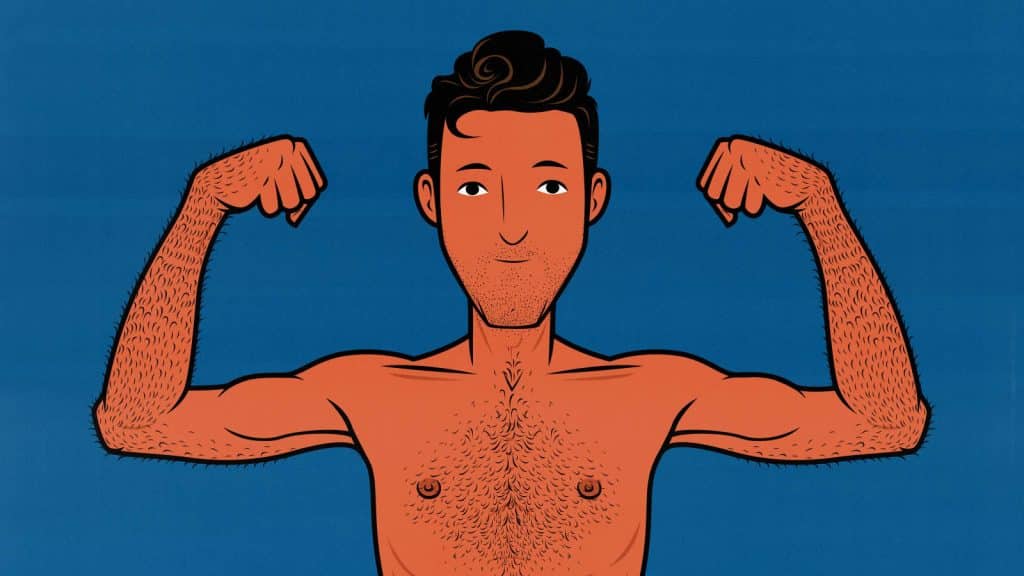
Why Am I So Skinny? Skinny Genetics Explained
I’m naturally skinny. Both of my parents were, too. My dad was nicknamed “Mop” because of his shaggy hair and stick-thin body. My mum was nicknamed “Lampshade” because of her bob haircut and flat figure.
In my early twenties, I weighed 125 pounds at 6’2, with a BMI of 16. That’s clinically underweight, and my doctor never let me forget it. Nobody did. So, I dove deep down the rabbit hole of trying to figure out why I was so much skinnier than everyone else I knew.
There are a few genetic factors that make some people naturally skinny. We often have thinner bones, fewer fat cells, faster metabolisms, smaller stomachs, and a different hormonal response to food. Sometimes, our organs work a little harder than usual, burning extra calories. I’ll go into all of this in a second.
None of those genetic traits make it impossible to gain weight. There are several solutions for all of them. It’s just that while most people gain weight by accident, we need to do it on purpose. Having skinny genetics also comes with several huge advantages. I’ll cover those, too.
It took me a little over a year to bulk to a healthy body weight. I blogged about how I gained 70 pounds, teamed up with a renowned strength coach, and have spent the past 15 years helping other skinny people understand their genetics, build muscle, and improve their health.
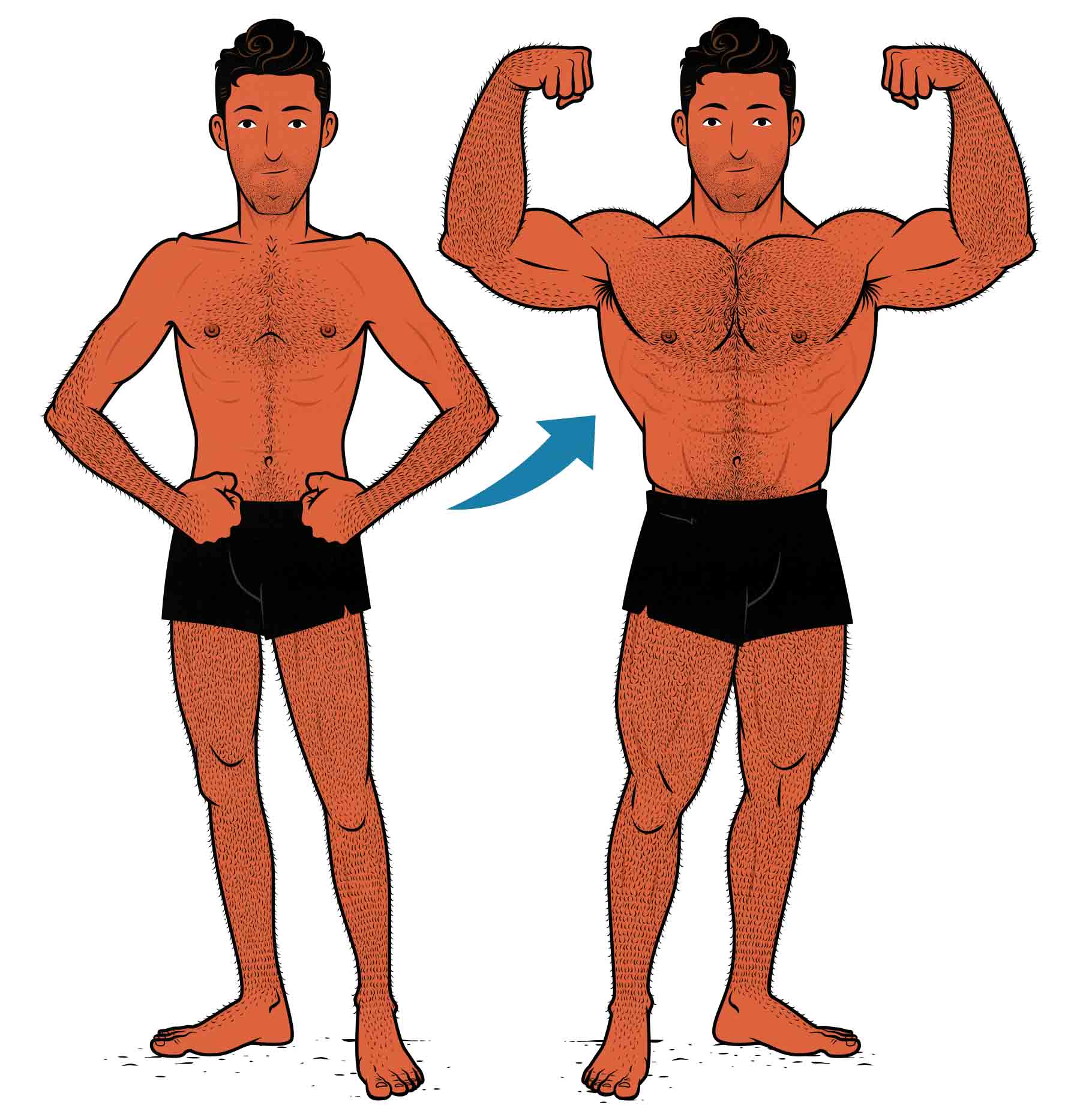
My Experience With Skinniness
Before we delve into why you’re skinny, let me prove that I know what I’m talking about. Here’s my before and after photo, showing me at 130 and 200 pounds:
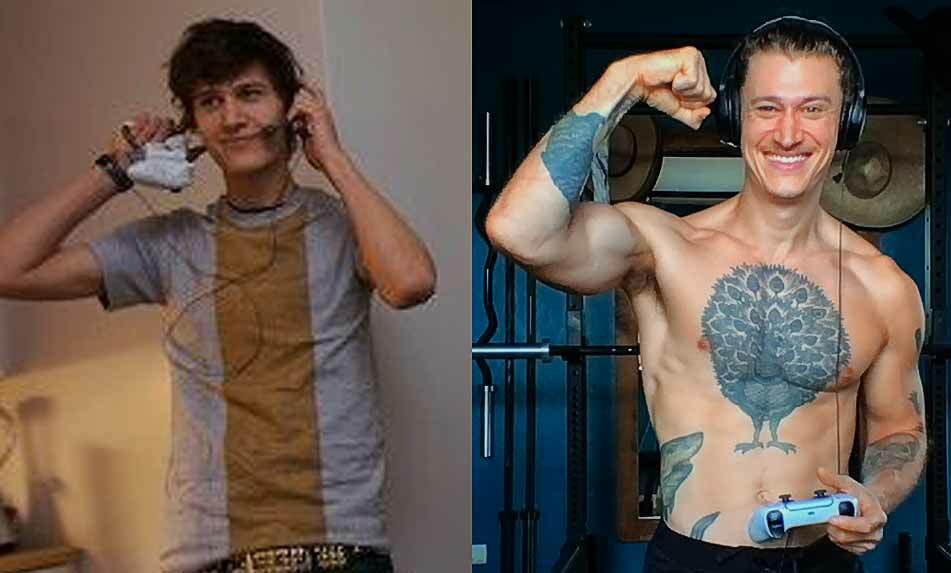
In that “before” photo, I weighed 130 pounds. That was the heaviest I’d ever weighed. My normal weight was closer to 120 pounds. I was in my early 20’s and already at high risk of having a heart attack (exacerbated by my familial hypercholesterolemia). My father had a heart attack in his forties. My cardiologist told me I was on track to get there sooner.
After graduating with a degree in fine arts, I started a little graphic design firm with my friend, Jared. He was just as skinny as I was, and he was taking prescription medication to manage his tendon pain. He wasn’t strong enough to sit at his desk for a full day of graphic design.
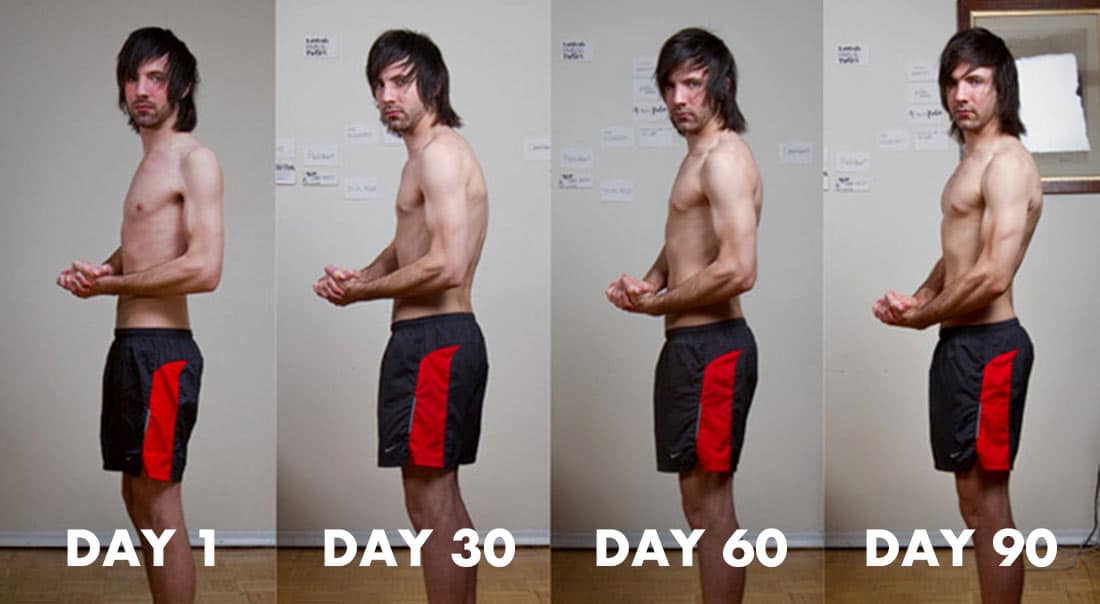
We decided to bulk up together after work, blogging about it as we went. You can see Jared’s first 3 months of progress above, showing over 30 pounds of weight gain, virtually all of it lean. It also improved his tendon pain, fixed his posture, and got him into much better health.
This was in 2010, when the online fitness industry was still in its early days. We had no idea what we were doing, but our blog gained traction. We started helping other skinny guys bulk up, for free, after finishing our work for the day. That brought us into contact with Marco:
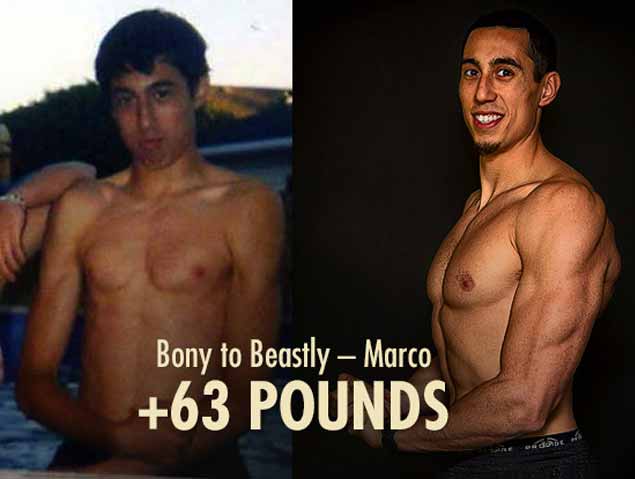
Marco was naturally skinny, too, yet he was thriving in his body. He had a degree in Health Sciences (BHSc), had studied under Eric Cressey (the head strength coach for the New York Yankees), and was running his own business as a strength coach, helping college, professional, and Olympic athletes bulk up.
The three of us teamed up to create Bony to Beastly, and we’ve been running it for the past 15 years, working with over 15,000 naturally skinny clients, male and female, young and old:
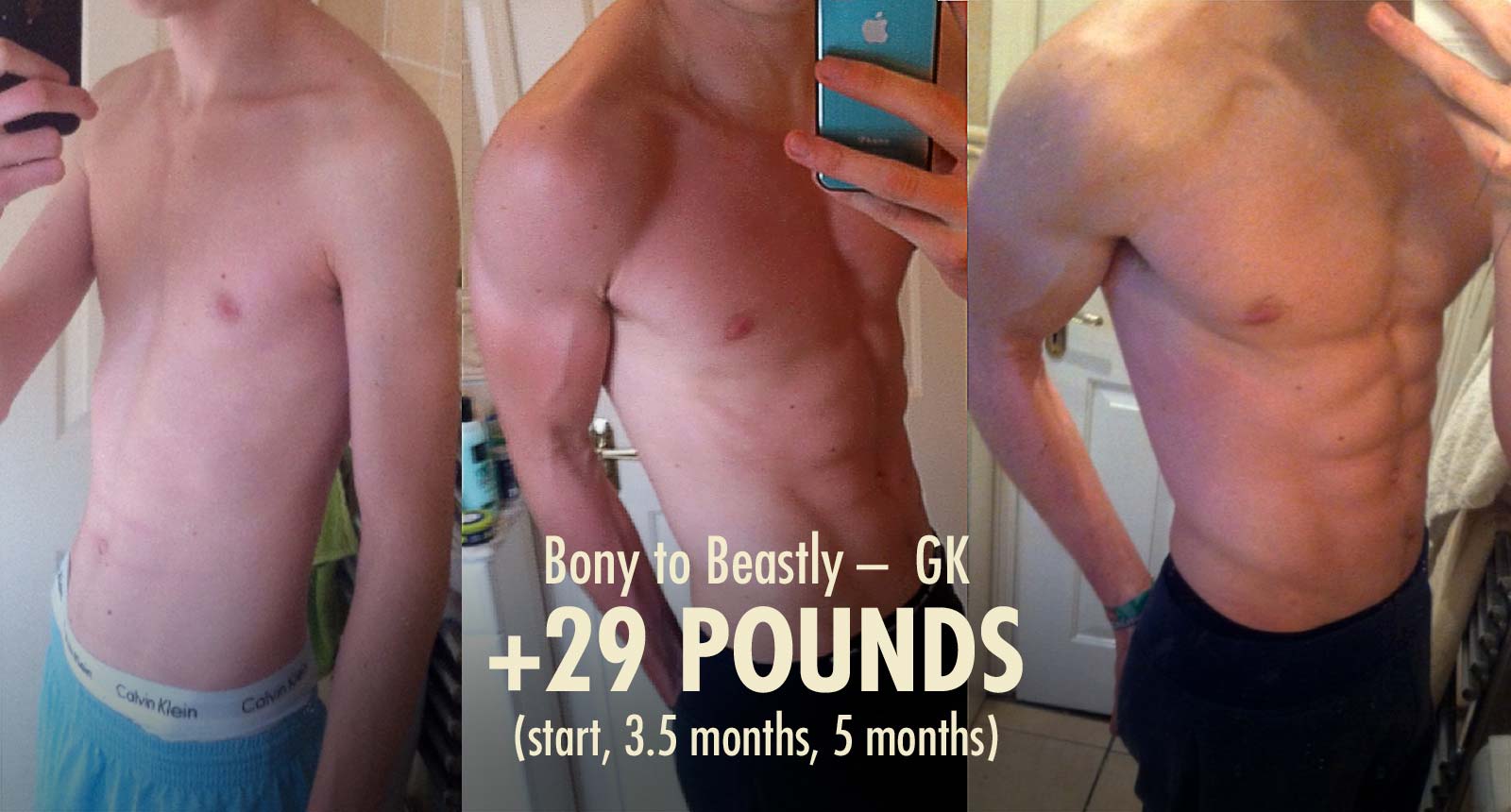
Then, to dedicate myself even more fully to the cause, I married a naturally thin nutritionist. She has a weight-gain transformation, too:

I’ve also spoken with some of the top nutritionists, dietitians, and researchers about skinniness, health, and muscle growth. There are quite a few factors that can make someone naturally skinny. I’ll cover all of the major ones.
The Skinny Body Type
To start, let’s get on the same page about what it means to be naturally skinny. We’re often tall, lanky, and narrow-shouldered, with small stomachs, thin bones, narrow rib cages, and raging metabolisms. It’s rare to have all of those traits, but having even one or two can be enough to make you skinny.
The naturally skinny body type is often called the “ectomorph” body type. It’s named for the ectoderm—the skin. The psychologist who coined it was trying to link skinniness with being nervous, fidgety, and introverted. That describes me pretty well, but it’s just a coincidence. The research didn’t pan out. Skinniness isn’t linked to personality traits. It’s just a body type. The word “ectomorph” stuck around as a term for naturally skinny people, but there’s no science behind it.
Whatever you call our body type, it isn’t a bad thing. We’re naturally thin because it was useful in certain evolutionary circumstances. I’d argue it’s more useful than ever in the modern world, where almost everyone else is struggling against obesity.
Once you understand the skinny body type, I think you’ll be grateful for it. That’s how it was for us, and that’s what we hear from almost every client.
Thinner Bones Structures
Thinner Bones Support Less Muscle
The first reason you might be skinny is that you have thin bones and a narrow bone structure. For example, I’m 6’2 but have much thinner wrists than the average 5’10 man. Having narrower bones makes me thinner and lighter, and it also means my bone structure can’t support as much muscle mass. That sounds bad, but it isn’t really—more on that in a second.
Most of that research comes from Dr. Casey Butt. He measured the bone structures of natural (male) bodybuilders in peak condition, finding that the thickness of your wrist and ankle bones are the best predictors of how much muscle you can build. I made a muscular potential calculator here, using his formulas and explaining his research.
If a man is short but has thick wrists, you’d expect him to be able to build bigger arms than a man who is tall but has thin wrists. Both of those guys can build arms that are 16+ inches, so the limitation won’t be a long-term issue (unless you plan to pursue professional bodybuilding or powerlifting). Still, it’s harder and takes longer for thin people to fill out their frames, and it almost never happens by accident.
That means if you want to be muscular, you need to train for it directly, and you need to be smart about it. Playing sports and being active probably won’t be enough. Even strength training might not be enough. If you want the benefits of being bigger, stronger, and more muscular, it really pays to train for muscle size—hypertrophy training.
You Can’t Build Thicker Bones
You’re stuck with your bone structure. Perhaps there’s something you can do to influence your bone structure while you’re growing up, but it hasn’t been well studied, and there’s nothing we can do as adults. Lifting weights, running, and doing martial arts will make your bones harder and denser, but they won’t get (much) thicker.
That doesn’t matter, though. Not being able to hold quite as much muscle on your frame isn’t bad for our health or longevity. It doesn’t even look bad. Dr. Casey Butt found that people with thinner bone structures tend to look better with thinner builds. For example, if your genetics allow you to build 16-inch arms, you’ll probably look best with 15-inch arms anyway, so there’s no issue.
We Still Build Muscle Quickly
Most skinny people assume they have poor muscle-building genetics. That isn’t quite true. Having thinner bones can limit muscle growth, but that isn’t a problem until you get quite muscular.
If you’re still “skinny,” then you aren’t close to your genetic potential yet, and your bone structure won’t limit your muscle growth. In fact, skinny people start further from their genetic potential, so we tend to build muscle faster.
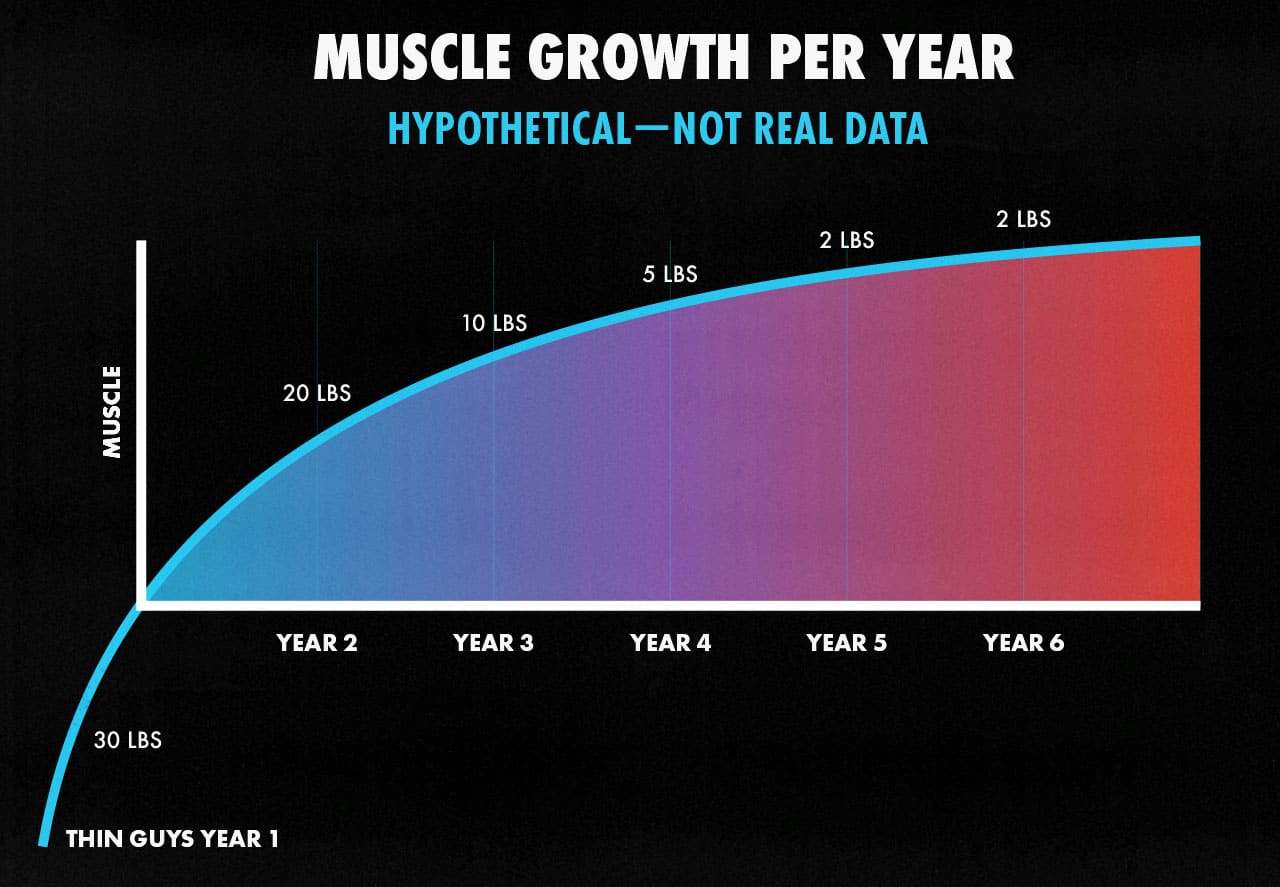
Here’s how it works: The further you are from your genetic potential, the faster you can build muscle. That’s why beginners go through the beloved “newbie gain” period, where they gain muscle very quickly and easily. The skinnier you are, the further you are from your genetic potential, so the faster you’ll be able to build muscle—at least at first.
This isn’t as controversial as it sounds. I spoke with the hypertrophy researcher, Dr. Eric Helms. This hasn’t been studied directly, so he couldn’t be sure, but he said that based on the current research, my theory sounds correct.
get the google spreadsheet of the
free beginner’s full-body workout
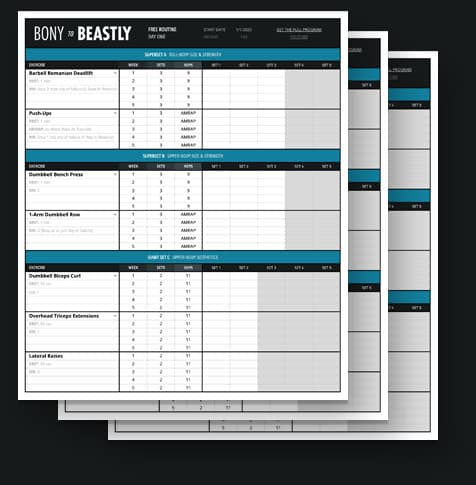
Get the workout as a Google spreadsheet. You’ll be able to pick from exercise alternatives, fill out the sheet, and get our beginner’s warm-up.
Plus, we’ll make sure you’re on the b2B newsletter, and send you all of our best muscle-building content.
Why Is It So Hard To Gain Weight?
It’s hard to eat enough calories to gain weight. That’s why we’re skinny. It takes around 800 calories to gain a pound of muscle and 3,500 calories to gain a pound of fat (full explanation). That means to gain a pound per week, you’d need to get into a calorie surplus of 150–500 extra calories per day.
Allen’s Rule (Body Shape)
Getting into a calorie surplus is easier for some people than others. There are a few reasons for that. Let’s start with the least important and more tenuous one.
The biologist Joel Asaph Allen noticed that longer, leaner bodies have a greater surface area per unit of mass, causing us to radiate more heat outwards. Have you ever noticed that if you curl up into a ball, you conserve more heat than if you lie spread-eagled? Overweight people are balls; we’re eagles.

Some people adapted to be shorter and stockier, making it easier to conserve heat and energy. Other people adapted to be taller and thinner, making it easier to radiate heat outwards. We have the body type that lets us run ultramarathons through the desert. But being able to radiate so much heat means we need to burn more calories to maintain our body temperatures.
This isn’t an advantage or disadvantage. We’re just better at different things. The giraffe is good at keeping cool; the polar bear is good at keeping warm. We’re more like the giraffe.
Fewer Fat Cells
People who are naturally thin tend to have fewer fat cells (study). Someone naturally lean might have 30 billion fat cells. Having 40–60 billion fat cells is normal (study). Some people have as many as 300 billion (study).
Every year, about 10% of fat cells die and get replaced, keeping the number steady. When we gain and lose weight, our fat cells swell and shrink, but we don’t gain or lose cells.

Here’s why that helps us: When you gain fat, your fat cells grow larger, storing that extra energy and telling your body that you can stop overeating. When you lose fat, those fat cells shrink, giving you energy and signalling your body to eat more food.
When you have fewer fat cells, you can be lean while keeping your fat cells pleasantly full, meaning they won’t cry out for more food, and you won’t be inclined to overeat. That makes it very easy to stay lean.
There are some interesting implications of this. For example, if a thin person does a “dreamer bulk” where they accidentally gain too much fat, that fat tends to melt right off.
Most skinny people eventually get skinny fat if they’re sedentary and don’t eat well, but that’s still a far cry from the amount of fat most sedentary people gain. We wind up at 25% body fat instead of 35%.
Faster Metabolisms
Most of our body weight comes from muscle, bone, and fat, all of which burn a predictable number of calories per day. Muscle burns around 6 calories per day at rest (full explanation). Fat burns 2. So, you’d expect the person who weighs more to burn more calories.
However, your heart, kidneys, and liver can all burn 200+ calories per pound per day. Small variations in the metabolic rate of those organs can change someone’s metabolism quite a lot, and you’d never be able to tell from looking at them.
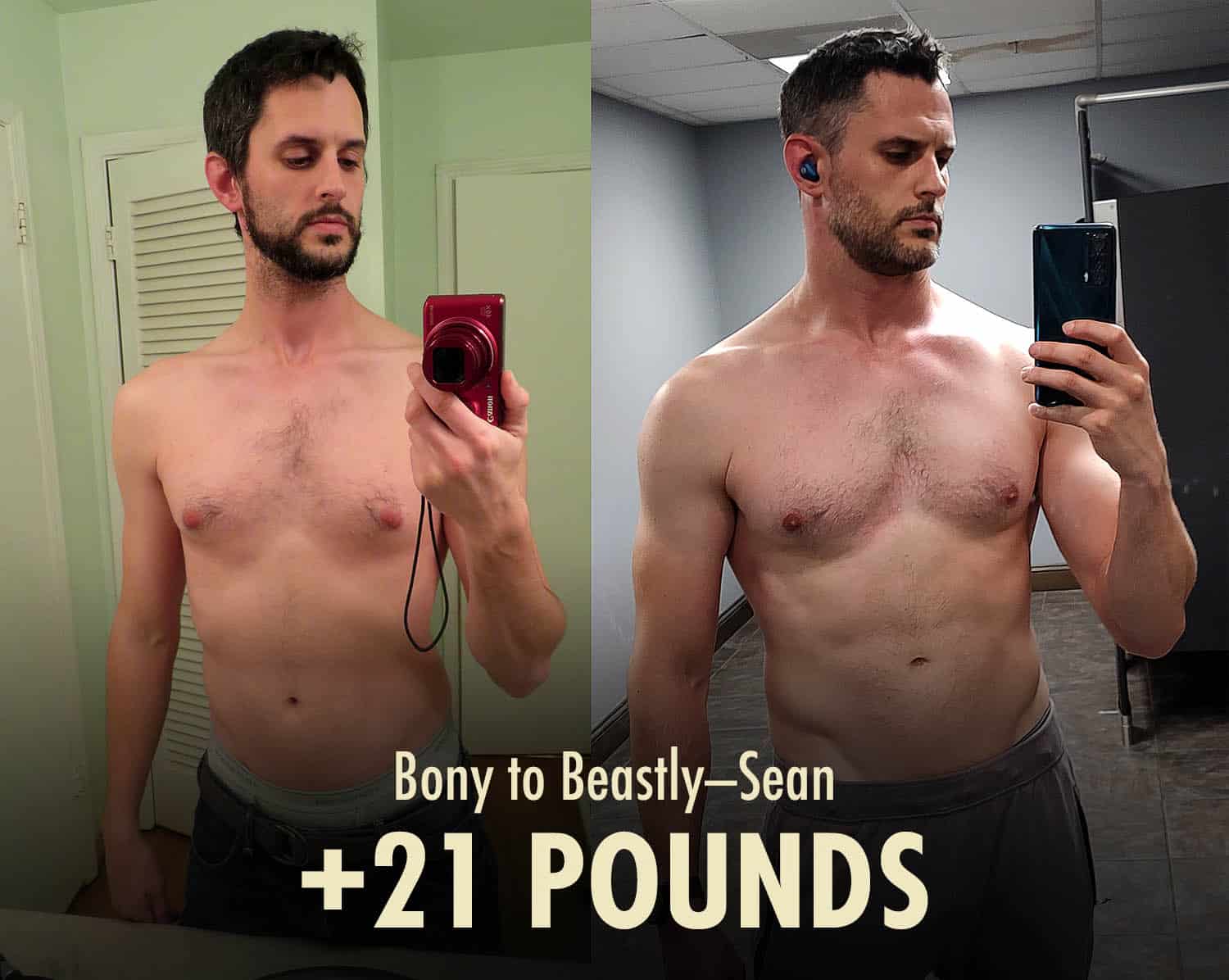
I wrote a full article about skinny metabolisms here. There’s a calculator there where you can plug in your stats, and it will tell you how fast or slow your metabolism could be. The variation is surprisingly large.
For example, if you’re 150 pounds, you probably burn 1600–1900 calories per day at rest (BMR), but you could burn anywhere between 1300 to 2200 calories (study, study, study). That’s a 900-calorie difference between the extreme ends! And that’s not even accounting for how active you are.
Adaptive Metabolisms
Your metabolism can change and adapt. There’s a famous old study where the researchers locked people up in a metabolic ward so they could control exactly how much food they ate (study). The researchers overfed everyone by a thousand calories per day. Most people gained 5 pounds, but one guy gained 10 pounds, and another gained less than 1. That last guy was dubbed a “hardgainer.”
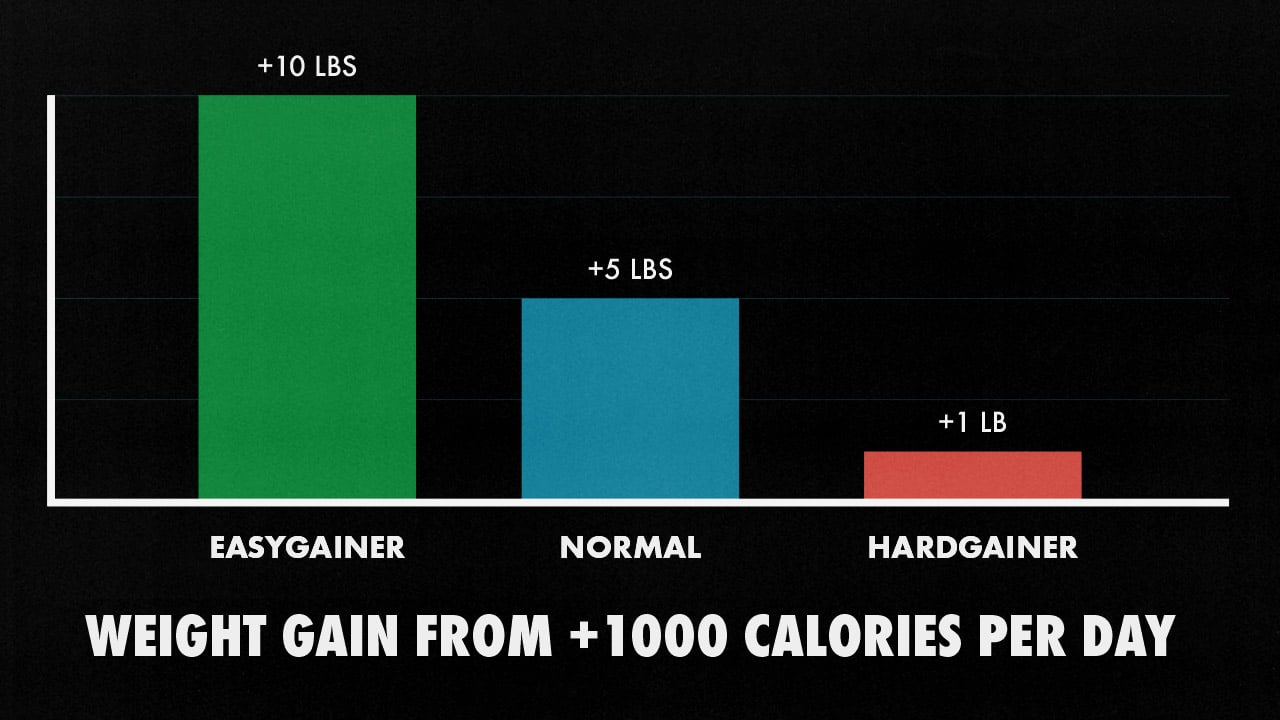
The main way your metabolism adapts is by adjusting how active you are (NEAT). For example, if there’s a famine, and you can’t find enough food, then your body will encourage you to be calmer, quieter, and more restful. On the other hand, if there’s plenty of food around, you might find yourself brimming with so much vigour that you pace around and fidget (study).
It gets weirder. Some people sit and stand more efficiently than others (study):

There are only so many calories you can burn per day. Eventually, if you keep eating more food, you’ll start gaining weight. But you might need to add quite a few calories to your diet before your weight starts moving up.
For example, you might be able to add 500 calories to your diet without gaining any weight, but then if you add another 200, you might start gaining half a pound per week.
get our bulking recipes—smoothies, snack, & protein balls
4 free bulking recipes

Get four bulking recipes in a downloadable PDF file. Get the full explanation, ingredient list, macros, and steps to follow.
Plus, we’ll make sure you’re on the b2B newsletter, and send you all of our best muscle-building content.
Stomach Size
Stomach size can vary quite a lot between people (study). It can also change depending on how much you usually eat. I used to think I had a tiny stomach, and that was true at the time, but it’s grown bigger over the years, and it’s gotten very easy to eat enough calories to maintain my body weight, even though I weigh 70 more pounds than I used to.
It seems that when your stomach is full, it signals your body that you’ve had enough to eat. That means if you have a smaller stomach, you’ll feel full after eating smaller amounts of food. If you try to eat past fullness, your stomach won’t be able to fit that much extra food.
There’s a reason that so many overweight people get surgery to make their stomachs smaller (gastric stapling). It usually causes quite a lot of weight loss. It’s easy to imagine, then, that having a naturally small stomach would make us naturally thinner.
Stress
Most people eat more junk food when stressed. Eating food releases relaxing hormones, helping them calm down. If you’re skinny, though, then I suspect you have the opposite response to stress. I bet you lose your appetite and forget to eat.
That means while most people accidentally gain a bit of weight during harder times, we accidentally lose a bit of weight. As time passes, their weight climbs up, whereas our weight drifts down.
Good types of stress might have the same effect. You might notice that when you’re excited, travelling, or having a good time, your friends are snacking away, but you forget to eat.
Summary
The reason you’re so skinny is that you have some combination of a thinner bone structure, fewer fat cells, a faster metabolism, a smaller stomach, and a lower appetite.
Most of these traits are either genetic or determined during childhood. As an adult, you can build a bigger appetite and stomach, but you’ll have a thinner bone structure and a natural leanness that lasts forever.
That means if you can find a way to eat more calories, you can probably build muscle faster and more leanly than most other people, but you won’t ever look stocky. If you accidentally gain fat, it will probably be very easy to lose. If you get out of shape, you’ll become “skinny fat” instead of obese.

Alright, that’s it for now. If you want us to walk you through the process of building muscle as a naturally skinny person, check out our Bony to Beastly Program (for men) or Bony to Bombshell Program (for women).
Both programs include a full workout routine, diet guide, and lifestyle recommendations. We’ll also give you a recipe book full of nutritious meals with all of the calories and macros calculated out for you. And we’ll coach you through the entire program, helping you gain 20 pounds—guaranteed.
Shane Duquette is the founder of Outlift, Bony to Beastly, and Bony to Bombshell, each with millions of readers. He's a Certified Conditioning Coach (CCC), has gained 70 pounds, and has over a decade of experience helping more than 15,000 people build muscle. He also has a degree in fine arts, but those are inversely correlated with muscle growth.
